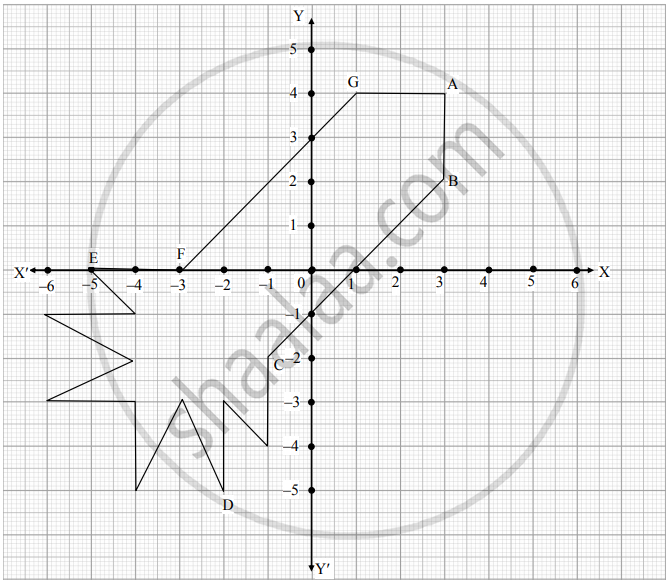Advertisements
Advertisements
प्रश्न
Show that the points A(3,0), B(4,5), C(-1,4) and D(-2,-1) are the vertices of a rhombus. Find its area.
उत्तर
The given points are A(3,0), B(4,5), C(-1,4) and D(-2,-1)
`AB = sqrt((3-4)^2 + (0-5)^2 ) = sqrt((-1)^2 +(-5)^2)`
`= sqrt(1+25) = sqrt(26)`
`BC = sqrt((4+1)^2 +(5-4)^2) = sqrt((5)^2 +(1)^2)`
`= sqrt(25+1) = sqrt(26)`
`CD = sqrt((-1+2)^2 +(4+1)^2) = sqrt((1)^2 +(5)^2)`
`= sqrt(1+25) = sqrt(26)`
`AD = sqrt((3+2)^2 +(0+1)^2) = sqrt((5)^2 +(1)^2)`
`= sqrt(25+1) = sqrt(26)`
`AC = sqrt((3+1)^2 + (0-4)^2) = sqrt((4)^2+(-4)^2)`
`= sqrt(16+16) =4sqrt(2)`
`BD = sqrt((4+2)^2 +(5+1)^2 ) = sqrt((6)^2+(6)^2)`
`= sqrt((36+36)) = 6 sqrt(2) `
`∵ AB = BC =CD =AD = 6 sqrt(2) and AC ≠ BD `
Therefore, the given points are the vertices of a rhombus
Area (Δ ABCD ) =`1/2 xx AC xxBD`
`= 1/2 xx 4 sqrt(2) xx 6 sqrt(2 ) = 24 ` sq. units
Hence, the area of the rhombus is 24 sq. units.
APPEARS IN
संबंधित प्रश्न
Find the third vertex of a triangle, if two of its vertices are at (−3, 1) and (0, −2) and the centroid is at the origin.
Find a point on y-axis which is equidistant from the points (5, -2) and (-3, 2).
Find the points of trisection of the line segment joining the points:
(2, -2) and (-7, 4).
Three consecutive vertices of a parallelogram are (-2,-1), (1, 0) and (4, 3). Find the fourth vertex.
Points P, Q, R and S divide the line segment joining the points A(1,2) and B(6,7) in five equal parts. Find the coordinates of the points P,Q and R
Find the value of a, so that the point ( 3,a ) lies on the line represented by 2x - 3y =5 .
ΔXYZ ∼ ΔPYR; In ΔXYZ, ∠Y = 60o, XY = 4.5 cm, YZ = 5.1 cm and XYPY =` 4/7` Construct ΔXYZ and ΔPYR.
If the points A(−1, −4), B(b, c) and C(5, −1) are collinear and 2b + c = 4, find the values of b and c.
If points Q and reflections of point P (−3, 4) in X and Y axes respectively, what is QR?
If the distance between the points (4, p) and (1, 0) is 5, then p =
The line segment joining points (−3, −4), and (1, −2) is divided by y-axis in the ratio.
The ratio in which the x-axis divides the segment joining (3, 6) and (12, −3) is
If the points(x, 4) lies on a circle whose centre is at the origin and radius is 5, then x =
If points A (5, p) B (1, 5), C (2, 1) and D (6, 2) form a square ABCD, then p =
The ratio in which the line segment joining points A (a1, b1) and B (a2, b2) is divided by y-axis is
Write the equations of the x-axis and y-axis.
Abscissa of all the points on the x-axis is ______.
A point both of whose coordinates are negative will lie in ______.
Ryan, from a very young age, was fascinated by the twinkling of stars and the vastness of space. He always dreamt of becoming an astronaut one day. So, he started to sketch his own rocket designs on the graph sheet. One such design is given below :

Based on the above, answer the following questions:
i. Find the mid-point of the segment joining F and G. (1)
ii. a. What is the distance between the points A and C? (2)
OR
b. Find the coordinates of the points which divides the line segment joining the points A and B in the ratio 1 : 3 internally. (2)
iii. What are the coordinates of the point D? (1)
